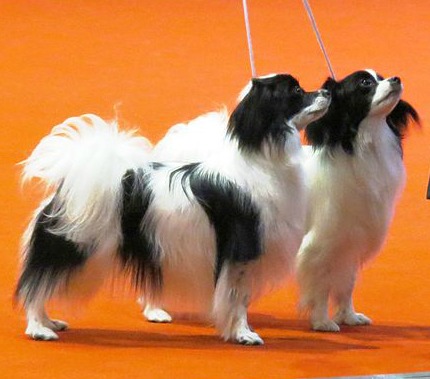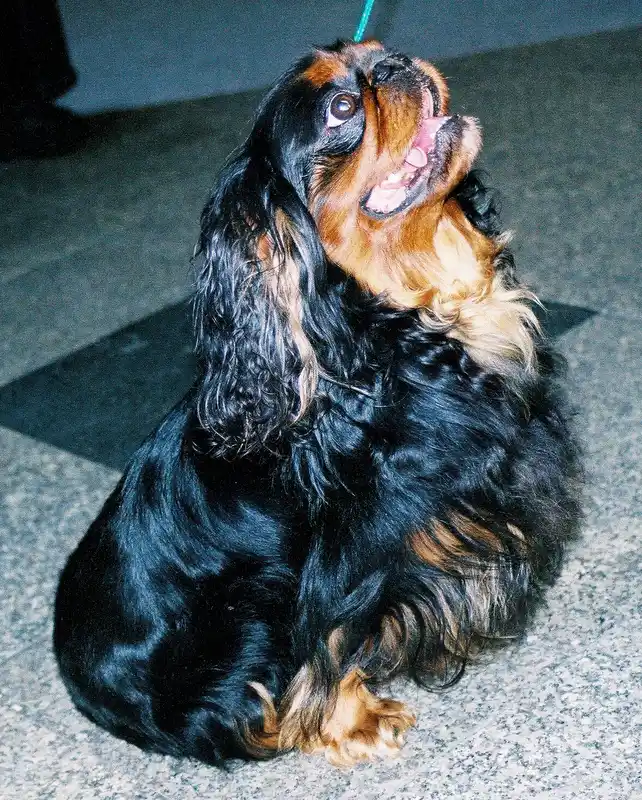Chinese Crested Dog
The Chinese Crested Dog is a small, affectionate breed known for its playful nature and unique appearance. They come in hairless and powderpuff varieties, making them ideal companions for families and individuals.
Overview
🐕Breed Overview
✨Key Traits
💡What Makes Chinese Crested Dog Special
Chinese Cresteds are characterized by their unique appearance and charming personality. Their hairless variety features soft, silky hair on the head, tail, and feet, while the powderpuff variety has a full coat of soft fur.
They are playful and energetic, often engaging in interactive play with their families. Their affectionate nature makes them great lapdogs, and they thrive on human interaction.
Cresteds are also known for their agility and intelligence, excelling in obedience and agility training. Their friendly disposition allows them to get along well with other dogs and pets, making them a versatile addition to any household.
The Chinese Crested Dog is a unique and affectionate breed known for its playful personality and striking appearance. With a height of 11 to 13 inches and a weight ranging from 5 to 12 pounds, this small dog is perfect for families and individuals alike. The breed comes in two varieties: the hairless, with soft, silky hair on its head, tail, and feet, and the powderpuff, which boasts a full coat of soft, straight hair.
Both varieties are known for their friendly and loving nature, making them excellent companions. Historically, the Chinese Crested has roots dating back to the 16th century, where they were used by Chinese seafarers as ratters on ships. Their charming demeanor and unique looks have made them popular in dog shows and as therapy dogs.
They are highly intelligent and eager to learn, though they can be somewhat stubborn, requiring a patient and gentle approach to training. With a lifespan of 13 to 15 years, the Chinese Crested is generally healthy but can be prone to certain conditions such as primary lens luxation and patellar luxation. Their grooming needs are moderate, particularly for the hairless variety, which requires regular skin care to prevent dryness and sunburn.
Overall, the Chinese Crested Dog is a delightful breed that thrives on companionship, making them a perfect fit for families, singles, and those looking for a loving and playful pet.
🎉Fun Facts
Chinese Cresteds have been known to sing and perform tricks.
Known as the 'Dr. Seuss dog' due to its whimsical appearance.
The breed has a unique hairless gene that can lead to a variety of hair types in the same litter.
They are hypoallergenic, making them suitable for allergy sufferers.
Breed Characteristics
Family & Friends
Good Behavior
Get Up & Go
Household Harmony
Temperament & Personality
✨Key Traits
🐕Core Temperament
The temperament of the Chinese Crested Dog is a delightful mix of playfulness and sensitivity. They are devoted companions who bond closely with their families and are eager to please.
Their friendly nature makes them approachable and sociable, both with humans and other animals. However, they can be timid around strangers if not properly socialized.
Cresteds are known for their gentle demeanor, making them suitable for families with children. They thrive on companionship and do not do well when left alone for extended periods.
💫Personality Profile
The Chinese Crested Dog is a lively and affectionate breed that thrives on human companionship. They are known for their playful and friendly demeanor, making them excellent family pets.
Cresteds are generally good with children and other pets, displaying a gentle and forgiving nature. Their intelligence allows them to learn quickly, although they can be somewhat stubborn at times.
Proper socialization is essential to ensure they are comfortable around strangers and new environments. Overall, they are loving companions who enjoy being the center of attention.
🔊Vocal Tendencies
Chinese Cresteds are generally not excessive barkers, but they will alert their owners to visitors or unusual sounds. Their vocalizations can range from soft whines to playful barks, especially when they are excited or seeking attention. Proper training and socialization can help manage their barking tendencies, ensuring they are well-behaved in various situations.
Affection & Social Traits
Energy & Activity
Communication Style
Care Requirements
🏃♂️Exercise Requirements
Daily Exercise
The Chinese Crested Dog has low exercise needs, requiring minimal physical activity to stay healthy and happy. A daily walk of about 20-30 minutes is sufficient for this breed, along with some playtime indoors or in a secure yard.
They enjoy interactive games like fetch or agility training, which can provide mental stimulation as well. Puppies may have bursts of energy and require more frequent short play sessions, while seniors may prefer gentler activities.
Regular exercise helps maintain their weight and supports their cardiovascular health, while insufficient activity can lead to boredom and potential behavioral issues such as chewing or excessive barking.
Preferred Activities
🏠Living & Adaptability
Space Requirements
Chinese Cresteds adapt well to various living environments, making them suitable for apartment living as well as homes with yards. They do not require a large outdoor space, but a safe area for play is beneficial.
Owners in smaller living situations should ensure their dog receives adequate exercise through indoor activities and regular walks. The breed's small size and low exercise needs make them ideal companions for city dwellers, but they also enjoy outdoor adventures in more rural settings.
Climate Preference
🍲Feeding Guide
Schedule
Food Types
Portion Size
Special Nutritional Needs
Chinese Cresteds may require a diet rich in omega fatty acids to support skin health, especially for the hairless variety. Owners should monitor for food allergies and adjust their diet accordingly. Regular dental care is essential, particularly for the hairless variety, which can have dental issues.
✨Grooming Requirements
Grooming Overview
The grooming needs of the Chinese Crested Dog vary between the hairless and powderpuff varieties. The hairless variety requires regular skin care, including moisturizing to prevent dryness and sunburn.
Owners should apply hypoallergenic or oil-free creams to keep the skin healthy. Regular bathing is necessary to maintain skin cleanliness and prevent blackheads.
The powderpuff variety requires brushing every few days to prevent matting and maintain a clean appearance. A light spray of water or grooming spray can help during brushing to avoid damaging the coat.
Care Schedule
Hairless: Moisturize every other day, bathe weekly; Powderpuff: Brush every 2-3 days, bathe monthly.
Health Profile
⚕️Health Care
Regular veterinary check-ups, vaccinations, and preventive care are essential for maintaining the health of a Chinese Crested Dog. Dental care is particularly important for the hairless variety, which may have dental issues. Early detection of health problems through routine examinations can significantly impact their lifespan and quality of life.
Health Issues Overview
⏳Average Lifespan
Genetic Factors
Genetics play a significant role in the Chinese Crested Dog's lifespan, with certain hereditary conditions affecting their health. Responsible breeding practices that prioritize genetic diversity can help reduce the risk of inherited health problems. Potential owners should seek breeders who conduct health testing and provide clear lineage information to ensure the best chance of a healthy dog.
Living Conditions
The Chinese Crested Dog's lifespan can be influenced by their living environment. A stable, loving home with regular veterinary care and a balanced diet can promote longevity.
Exposure to extreme temperatures should be minimized, particularly for the hairless variety, which is more susceptible to cold and sunburn. Regular exercise and mental stimulation also contribute to overall health and well-being, helping to prevent obesity and related health issues.
🏥Common Health Issues
Primary Lens Luxation
Warning Signs
🔬Diagnosis
Veterinary ophthalmologists can diagnose through eye examinations.
💊Treatment
Surgical intervention may be necessary in severe cases.
📝Management Tips
Regular eye exams and genetic testing for carriers can help manage risks.
Patellar Luxation
Warning Signs
🔬Diagnosis
Physical examination by a veterinarian.
💊Treatment
Surgical correction may be needed.
📝Management Tips
Weight management and physical therapy can help; surgery may be required in severe cases.
Progressive Retinal Atrophy (PRA)
Warning Signs
🔬Diagnosis
Genetic testing and veterinary examination.
💊Treatment
No cure; supportive care is recommended.
📝Management Tips
Regular veterinary check-ups to monitor eye health.
🛡️Preventive Care
🔬Ophthalmic Examination
Eye examinations to detect conditions like PRA and lens luxation early.
📅 Annually, or as recommended by a veterinarian.
🔬Orthopedic Evaluation
Physical examinations to assess joint health and detect patellar luxation.
📅 Annually, or as needed based on age and activity level.
🔬Genetic Health Testing
Genetic testing for hereditary conditions to assess risk factors.
📅 Before breeding, and as needed for health monitoring.
Training
🧠Intelligence & Trainability
💪Work Drive
Chinese Cresteds thrive on companionship and mental stimulation. They enjoy tasks that involve interaction with their owners, such as agility training or learning new tricks.
Providing them with puzzle toys or engaging activities can help satisfy their need for mental engagement. Without sufficient stimulation, they may become bored and exhibit undesirable behaviors.
⚠️Training Considerations
Chinese Cresteds can be somewhat stubborn and may require patience during training. Their independent nature can lead to challenges in obedience, especially if they sense a lack of consistency from their trainer.
Socialization is crucial to prevent timidity around strangers, and early exposure to various environments and people can help mitigate this. Positive reinforcement techniques work best, as harsh training methods can lead to anxiety or resistance.
📝Training Tips
Training a Chinese Crested should focus on positive reinforcement methods, using treats and praise to encourage desired behaviors. Short, engaging training sessions are ideal, as these dogs can lose interest quickly.
Consistency is key, and incorporating play into training can help maintain their enthusiasm. Teaching basic commands and tricks can be rewarding for both the dog and owner, fostering a strong bond and enhancing their social skills.
History & Heritage
📜Origin Story
The Chinese Crested Dog's origins are somewhat mysterious, with theories suggesting they may have descended from African hairless dogs. They were brought to China by traders and seafarers, where they became popular for their unique appearance and friendly demeanor.
The breed was used on ships to control vermin and was often traded in port cities. In the late 1800s, they began to gain recognition in dog shows, thanks to breeders like Gypsy Rose Lee, who helped popularize the breed in America.
Today, the Chinese Crested is celebrated for its affectionate nature and distinctive looks.
⏳Development History
The Chinese Crested Dog's history is complex, with roots tracing back to the 16th century. Initially, they were known as African Hairless Terriers before being recognized as a distinct breed in China.
The breed gained popularity in the 1800s, particularly in Europe and the United States, where dedicated breeders began to establish lineage and breed standards. The American Chinese Crested Club was founded in 1978, and the breed was officially recognized by the AKC in 1991, solidifying its status as a beloved companion dog.
🛡️Purpose & Historical Role
Originally bred as a ratter and companion, the Chinese Crested Dog has evolved into a beloved lapdog and therapy dog. Their playful and affectionate nature makes them excellent companions for families and individuals alike. They have also been recognized for their agility and obedience skills, participating in various dog sports and competitions.
🏺Cultural Significance
The Chinese Crested Dog has a rich history, believed to have originated in Africa and later brought to China. They were popular among Chinese seafarers who used them as ratters on ships, trading them as curiosities in ports.
This breed has been depicted in various forms of art and literature, often associated with nobility and companionship. Their unique appearance has made them a favorite in dog shows and competitions, and they have gained recognition in popular culture, including appearances in movies and television.
Conservation Status
This breed is well-established with healthy population numbers.









